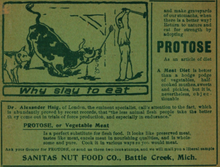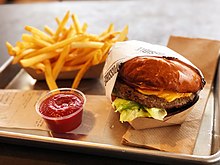Meat alternative



A meat alternative or meat substitute (also called plant-based meat, mock meat, or fake meat sometimes pejoratively), is a food product made from
Meat alternatives are typically consumed as a source of
Meat substitution has a long history. Tofu was invented in China as early as 200 BCE,
History



In the third century CE, Athenaeus describes a preparation of mock anchovy in his work Deipnosophistae:[9]
He took a female turnip, shred it fine
Into the figure of the delicate fish;
Then did he pour on oil and savoury salt
With careful hand in due proportion.
On that he strew'd twelve grains of poppy seed,
Food which the Scythians love; then boil'd it all.
And when the turnip touch'd the royal lips,
Thus spake the king to the admiring guests:
"A cook is quite as useful as a poet,
And quite as wise, and these anchovies show it."
Prior to the arrival of Buddhism, northern China was predominantly a meat-consuming culture. The vegetarian dietary laws of Buddhism led to development of meat substitutes as a replacement for the meat-based dishes that the Chinese were no longer able to consume as Buddhists. Meat alternatives such as tofu and wheat gluten are still associated with
John Harvey Kellogg developed meat replacements variously from nuts, grains, and soy, starting around 1877, to feed patients in his vegetarian Battle Creek Sanitarium.[12] Kellogg's Sanitas Nut Food Company sold his meat substitute Protose, made from peanuts and wheat gluten. It became Kellogg's most popular product as several thousand tons had been consumed by 1930.[12]
There was an increased interest in meat substitutes during the late 19th century and first half of the 20th century.[13] Prior to 1950, interest in plant-based meat substitutes came from vegetarians searching for alternatives to meat protein for ethical reasons, and regular meat-eaters who were confronted with food shortages during World War I and World War II.[13]
Henrietta Latham Dwight authored a vegetarian cookbook, The Golden Age Cook-Book in 1898 which included meat substitute recipes such as a "mock chicken" recipe made from breadcrumbs, eggs, lemon juice and walnuts and a "mock clam soup" made from marrowfat beans and cream.[14] Dietitian Sarah Tyson Rorer authored the cookbook, Mrs. Rorer's Vegetable Cookery and Meat Substitutes in 1909.[14] The book includes a mock veal roast recipe made from lentils, breadcrumbs and peanuts.[14] In 1943, Kellogg made his first soy-based meat analog, called Soy Protose, which contained 32% soy.[12] In 1945, Mildred Lager commented that soybeans "are the best meat substitute from the vegetable kingdom, they will always be used to a great extent by the vegetarian in place of meat."[15]
In July 2016,
Types
Some vegetarian meat alternatives are based on centuries-old recipes for
Production and composition
To produce meat alternatives with a meat-like texture, two approaches can be followed: bottom-up and top-down.[24] With bottom-up structuring, individual fibers are made separately and then assembled into larger products. An example of a meat alternative made using a bottom-up strategy is cultured meat. The top-down approach, on the other hand, induces a fibrous structure by deforming the material, resulting in fibrousness on a larger length scale. An example of a top-down technique is food extrusion.
The types of ingredients that can be used to create meat substitutes is expanding, from companies like Plentify, which are using high-protein bacteria found in the human microbiome,[25] to companies like Meati Foods, that are cultivating the mycelium of fungi—in this case, Neurospora crassa—to form steaks, chicken breasts, or fish.[26][27]
Soy protein isolates or soybean flour and gluten are usually used as foundation for most meat substitutes that are available on the market. Soy protein isolate is a highly pure form of soy protein with a minimum protein content of 90%. The process of extracting the protein from the soybeans starts with the dehulling, or decortication, of the seeds. The seeds are then treated with solvents such as hexane to extract the oil from them. The oil-free soybean meal is then suspended in water and treated with alkali to dissolve the protein while leaving behind the carbohydrates. The alkaline solution is then treated with acidic substances to precipitate the protein, before being washed and dried. The removal of fats and carbohydrates results in a product that has a relatively neutral flavor.[28] Soy protein is also considered a "complete protein" as it contains all of the essential amino acids that are crucial for proper human growth and development.[29]
After the textured base material is obtained, a number of
Commerce
Graphs are unavailable due to technical issues. There is more info on Phabricator and on MediaWiki.org. |
Graphs are unavailable due to technical issues. There is more info on Phabricator and on MediaWiki.org. |
Meat substitutes represent around 11% of the world's meat and substitutes market in 2020[update]. As shown in the graph, this market share is different from region to region.[33] From 2013 to 2021, the world average price of meat substitutes fell continuously, by an overall 33%. The only exception was a 0.3% increase in 2020, compared to 2019. The price will continue to decrease, according to projections by Statista (see average price graph).[34]
The motivation for seeking out meat substitutes varies among consumers. The market for meat alternatives is highly dependent on "
Vegan meats are consumed in restaurants, grocery stores, bakeries,
Impact
Environmental
Besides ethical and health motivations, developing better meat alternatives has the potential to reduce the environmental impact of meat production, an important concern given that the global demand for meat products is predicted to increase by 15 percent by 2031. Research on meats and no-meat substitutes suggests that no-meat products can offer substantial benefits over the production of beef, and to a lesser extent pork and chicken, in terms of greenhouse gas production, water and land use.[4] A 2022 report from the Boston Consulting Group found that investment in improving and scaling up the production of meat and dairy alternatives leads to big greenhouse gas reductions compared with other investments.[44]
According to
Pollution is the next largest contribution to wasted water. Pesticides used in animal feed production as well as waste runoff into reservoirs can cause ecological damage and even human illness as well as taking water directly out of the usable supply. Animal agriculture is the main contributor to the food sector greenhouse gas emissions. Production of plant-based meat alternatives emits 30–90% less than conventional meat production. While also contributing less to this total pollution, much of the land being used for animal feed could be used to mitigate the negative effects we've already had on the planet through carbon recycling, soil conservation, and renewable energy production.[45] In addition to the ecological harm caused by the current industry, excess antibiotics given to animals cause resistant microbes that may render some of the life-saving drugs used in human medicine useless. Plant-based meat requires no antibiotics and would greatly reduce microbe antibiotic resistance.[45]
A 2023 study published in Nature Communications found that replacing just half of the beef, chicken, dairy and pork products consumed by the global population with plant-based alternatives could reduce the amount of land used by agriculture by almost a third, bring deforestation for agriculture nearly to a halt, help restore biodiversity through rewilding the land and reduce GHG emissions from agriculture by 31% in 2050, paving a clearer path to achieving both climate and biodiversity goals.[46][47][48] The switch to plant-based protein is reported to deliver the biggest climate-heating emission cuts per investment dollar of all industrial sectors.[49]
Health
In 2021, the American Heart Association stated that there is "limited evidence on the short- and long-term health effects" of plant-based meat alternatives.[50] The same year, the World Health Organization stated that there are "significant knowledge gaps in the nutritional composition" of meat alternatives and more research is needed to investigate their health impacts.[51] An 2023 systematic review, however, concluded that replacing red and highly-processed meat with a variety of meat alternatives improved Quality Adjusted Life Years, led to significant health system savings, and reduced greenhouse gas emissions. Replacement of meat with minimally-processed vegetarian alternatives such as legumes had the greatest effect.[52]
Criticism
Companies producing plant-based meat alternatives, including Beyond Meat and Impossible Foods, have been criticized for their marketing and makeup of their products as well as their use of animal testing.[53] Dietitians have claimed they are not necessarily healthier than meat due to their highly processed nature and sodium content.[54][55]
Some consulting firms and analysts demand more transparency in terms of the environmental impact of plant-based meat.[60] Through a survey, analysts from Deloitte discovered that some consumers negatively linked meat alternatives to being "woke" and politically-left leaning.[61] These ideas emerged in response to Cracker Barrel's introduction of Impossible Sausages in their restaurants in August, 2022.[62] In 2021, 68% of consumers who purchased plant based meats believed it was healthier than animal meat. The number dropping to 60% in 2022, demonstrating a decline in consumers beliefs in the healthiness of these meats.[61]
Some states have instituted legislation stating that meat alternatives are not allowed to label themselves as "meat". In Louisiana, the so-called, "Truth in Labeling of Food Products Act" was challenged by Tofurkey, complaining of free speech violations[63] and was successful on those grounds.[64]
Alternative meats companies Beyond Meat and Impossible Foods have attempted to appeal to meat eaters. University of Oregon marketing professor Steffen Jahn thinks that this has run afoul of human psychology, saying “the mimicking of real meat introduces that comparison of authenticity.”[65] Jahn argues that marketing plant-based meats with traditional meats leads to an artificiality that many consumers do not love. Consumer psychologists split foods into categories of “virtue” and “vice” foods, which ultimately guide how products are marketed and sold. Virtue foods are those that less gratifying appealing in the short term, and typically healthier, whereas vice foods are the opposite, having more long term consequences.[66] Many ready-made meat alternatives combine these categories with their long list of ingredients. Consumers who are likely to want to be “virtuous” by avoiding damage to the environment or animals are also likely to want “virtuous” food in the form of simple ingredients.[65]
See also
- Vegetarian bacon
- Vegetarian hot dogs
- Vegetarian sausage
- Meat-free sausage roll
- Soy curls – Soy based meat alternative
- Cultured meat – Meat created outside of a living animal
- Egg substitutes – Food products which can be used to replace eggs in cooking and baking
- Insects as food – Use of insects as food for humans
- List of bacon substitutes
- List of meat substitutes
- List of vegetarian and vegan companies
- Leghemoglobin: alters flavor of certain meat alternatives to make them taste even more similar to meat ("simulates" animal blood in these meat alternatives but made from plant-based sources)
- Milk substitute – Alternative substance that resembles milk
- Single-cell protein, meat alternatives containing protein extract from pure or mixed cultures of algae, yeasts, fungi, or bacteria or made from air
- Timeline of cellular agriculture
References
- .
- .
- .
- ^ . Retrieved 1 August 2022.
- ^ "All sizzle, no steak: how Singapore became the centre of the plant-based meat industry". The Guardian. 5 November 2022.
- ^ ISBN 978-9971-69-413-5.
- ^ ISBN 978-0-313-32147-4.
- ISBN 978-1-928914-71-6.
- ^ Athenaeus. Deipnosophistae. Project Gutenberg. p. 11.
- ^ ISBN 978-1-928914-68-6.
- ISBN 978-0-520-95934-7.
- ^ a b c "Dr. John Harvey Kellogg and Battle Creek Foods". www.soyinfocenter.com.
- ^ ISBN 978-0-7546-3648-9
- ^ ISBN 978-1-4696-0891-4
- ^ Lager, Mildred M. (1945). The Useful Soybean: A Plus Factor in Modern Living. McGraw-Hill Book Company. p. 95
- Technology Review. Retrieved 28 July 2016.
- ^ Popper, Nathaniel (1 April 2019). "Behold the Beefless 'Impossible Whopper'". The New York Times. Retrieved 3 April 2019.
- ^ Chiorando, Marie (17 November 2019). "Impossible Whopper Is 'One Of Burger King's Most Successful Launches In History'". www.plantbasednews.org. Retrieved 7 February 2020.
- ^ Rivera, Dane (22 October 2019). "All The Major Fast Food Chains And Markets Selling Beyond Meat and Impossible Foods". Uproxx. Retrieved 10 January 2020.
- ^ Wiener-Bronner, Danielle (24 September 2019). "The Awesome Burger is Nestlé's answer to the plant-based meat craze". CNN Business. Cable News Network. Retrieved 7 February 2020.
- ^ Chung, Heidi (12 February 2020). "Food giant Kellogg's unveils 'Incogmeato' plant-based products". Yahoo! Finance.
- ^ Patterson, Daniel (6 August 2006). "The Way We Eat: I Can't Believe It's Tofu". The New York Times. Retrieved 26 February 2009.
- ^ EOS, April 2019, page 52
- .
- ^ Watson, Elaine (20 June 2020). "'Plentify' novel single cell protein 'ludicrously efficient' to produce vs animal protein, claims startup". Retrieved 26 June 2020.
- ^ Peters, Adele (29 October 2019). "If it looks like a steak and tastes like a steak, in this case, it's a mushroom". Fast Company. Retrieved 26 June 2020.
- ^ "What is the most technical and scientific way to understand what Meati is made from and how we are branding it?". Retrieved 18 October 2023.
- ^ Sedgwick, Tali (28 June 2013). "Meat Analogs". Food and Nutrition. Academy of Nutrition and Dietetics. Retrieved 10 December 2016.
- ^ US patent US2682466A High protein food product and process for its preparation Robert A. Boyer, published 29 June 1954 US patent 5285709, "Meat Analog Compositions." Robert A. Boyer, issued 29 June 1954
- ^ Perret, Marcel Andre (5 September 1972). "Chicken flavor and process for preparing the same".
- .
- .
- ^ a b "Uprooting tradition: What plant-based alternatives mean for the future of protein". Royal Bank of Canada. 21 May 2021. pp. 13–14. Archived from the original on 30 January 2022. Retrieved 30 January 2022. Formula: (Retail value meat substitutes) / (Retail value meat + retail value meat substitutes).
- ^ a b "Global: meat substitute price per unit 2013–2026". Statista. November 2021. Retrieved 29 January 2022.
all types of meat-like products that approximate certain aesthetic qualities (primarily texture, flavor, and appearance) or chemical characteristics of a specific meat. (...) includes plant-based meat and vegetarian meat [which] contains non-vegan ingredients
- ^ "Meat Substitutes – Worldwide | Statista Market Forecast". Statista. Retrieved 29 January 2022.
- ^ "CONSUMER INSIGHTS" (PDF). AHDB. July 2018. Retrieved 2 September 2020.
- ISSN 0029-6651.
- ^ Olayanju, Julia B. (30 July 2019). "Plant-based Meat Alternatives: Perspectives On Consumer Demands And Future Directions". Forbes. Retrieved 10 January 2020.
- ^ Cheng, Andria (29 July 2019). "Beyond Meat Q2 Sales Quadruple, But Replacing Meat? That's A Different Story". Forbes. Retrieved 10 January 2020.
- ^ Franck, Thomas (23 May 2019). "Alternative meat to become $140 billion industry in a decade, Barclays predicts". CNBC. Retrieved 10 January 2020.
- ^ Mourdoukoutas, Panos (31 August 2019). "Veganism And Vegetarianism Are Changing Fast Food". Forbes. Retrieved 10 January 2020.
- ISSN 0190-8286. Retrieved 22 April 2023.
- ISBN 9780807039878.
- ^ Carrington, Damian (7 July 2022). "Plant-based meat by far the best climate investment, report finds". The Guardian. Retrieved 10 July 2022.
- ^ a b c d The Good Food Institute. "Plant-based meat for a growing world". gfi.org. Retrieved 29 November 2022.
- ^ Marashli, Imran (16 September 2023). "Meat, milk alternatives could slash food system emissions a third: study". Phys.org. Retrieved 19 October 2023.
- PMC 10497520.
- ^ Graham, Max (14 September 2023). "New Study Shows Impacts of Cutting Meat and Dairy Consumption in Half". Mother Jones. Retrieved 25 October 2023.
- ^ "Plant-based meat by far the best climate investment, report finds". The Guardian. 7 July 2022.
- S2CID 240422142.
- ^ "Plant-based diets and their impact on health, sustainability and the environment: A review of the evidence". WHO European Office for the Prevention and Control of Noncommunicable Diseases.
- PMID 36567793.
- ^ "Why It's Impossible for PETA to Get Behind the Impossible Burger". Archived from the original on 27 July 2018.
- ^ Lucas, Amelia (4 July 2019). "Are Beyond Meat's plant-based burgers healthier than red meat? Dietitians say no". CNBC. Retrieved 2 September 2020.
- ^ Drayer, Lisa (2019). "They might be better for the planet, but are plant-based burgers good for you?". CNN Health. Retrieved 2 September 2020.
- ^ a b Lucas, Amelia (24 July 2019). "Beyond Meat CEO invites Chipotle for a tour after its fake meats are called too processed". CNBC. Retrieved 2 September 2020.
- ^ Lucas, Amelia (19 August 2021). "Chipotle is testing a meatless chorizo alternative in two markets". CNBC. Retrieved 25 August 2020.
- ^ Lucas, Amelia (3 January 2022). "Chipotle adds meatless chorizo to its menu for limited time". CNBC. Retrieved 3 January 2022.
- ^ Martin, Brittany (21 September 2022). "Taco Bell Is Putting Beyond Meat on the Menu – And We Tasted It". Vegetarian Times. Retrieved 22 April 2023.
- ISSN 0362-4331. Retrieved 8 November 2021.
- ^ a b "Plant based meat sales slowing". Deloitte Insights. Retrieved 5 December 2023.
- ^ Valinsky, Jordan (4 August 2022). "Cracker Barrel sparks uproar for plant-based sausage critics say is 'woke' | CNN Business". CNN. Retrieved 5 December 2023.
- ^ "Pickin' on Veggies: Louisiana's "Truth in Labeling of Food Products Act"". 22 January 2020.
- ^ "Veggie 'Meat' Maker Tofurky Wins Free Speech Challenge to Food-Labeling Law". 31 March 2022.
- ^ ISSN 0190-8286. Retrieved 5 December 2023.
- ISSN 0167-8116.
Further reading
- Yes, plant-based meat is better for the planet. Vox. 18 November 2021.
- Plant-based meat is a simple solution to climate woes – if more people would eat it. Associated Press. 1 December 2023.
